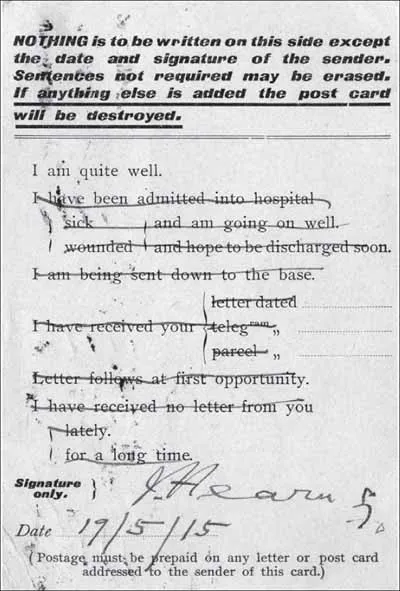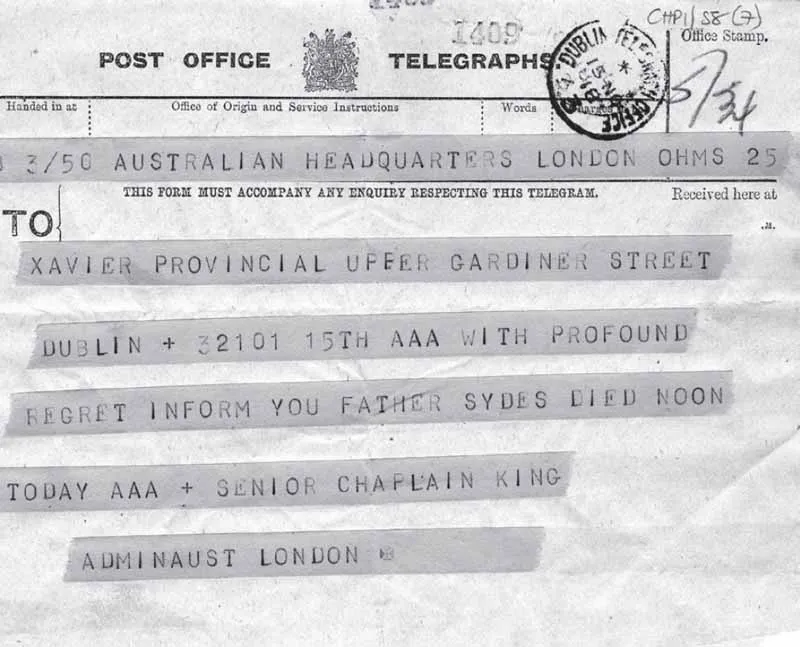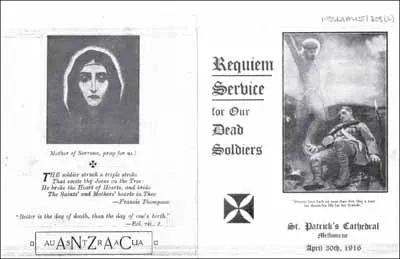![]()
Australia
Graham Wilson, Fr Michael Head SJ, Damien Burke
Field Service Postcard from Fr Joseph Hearn SJ to Father Provincial Thomas V Nolan SJ. May 19 th 1915. Reference: IJA/MSSN/ AUST/209/2.
Six Jesuits served as chaplains with the Australian Forces in the First World War; five belonged to the Australian Mission of the Irish Province (Michael Colman, William Gwynn, Joseph Hearn, Patrick Tighe and Edward Sydes) while Michael Bergin was attached to the Syrian Mission of the Lyons Province.1 The presence of Jesuits in Australian Forces in the war can be traced back to the revolutionary upheavals of mid-19th century Europe. Two Austrian Jesuits, Frs Kranewitter and Klinkowstroem arrived in Adelaide in 1848 after the expulsion of the Jesuits from Austria in that year. Over the next 53 years of their mission, the Austrian Jesuits administered to the pastoral needs of a mobile and expanding pioneering population, provided schooling, and co-operated in the training of a local priesthood. They had settled at Sevenhill, as they named their property, and established a centre from which they undertook 1,000-mile horseback journeys throughout the interior, built some thirty churches and a similar number of schools, established two schools of their own, a seminary, novitiate, mission centre and vineyards, and a twenty-year mission to the Aborigines of the Northern Territory.
While the Jesuit mission to South Australia was Austrian, the early Australian Church was fundamentally an Irish Church. After a number of petitions from Australian bishops, the Irish Jesuits arrived in Melbourne in 1865, where they found a population which had grown by 500% in ten years as a result of the Gold Rushes. Again, the need was for pastoral organisation, the forming of parishes, the training of local priests, and most especially education for a Catholic population that was largely illiterate. Fr Joseph Dalton SJ exercised a huge influence on the Irish Mission. He sent Jesuits into St Patrick’s College; formed the Richmond and Hawthorn parishes; purchased the land for Xavier College; established St Aloysius’ College in Sydney, the North Sydney parish, and St Ignatius’ College, Riverview, as well as another school in Dunedin, New Zealand.2 In 1901, the Austrian and Irish Missions amalgamated to form the Australian Mission, under the Irish Province.3
With the British declaration of war in August 1914, Australia was also at war. While Australia was not bound by either legislation or treaty to follow Britain’s lead, the familial bonds felt by most Australians for a country that many still referred to as ‘Home’ were so strong that the idea of Australia not going to the aid of the ‘Mother Country’ was virtually unthinkable. The national sentiment of the time is perhaps best expressed in the words of the then Leader of the Opposition, Andrew Fisher, who, during the Federal election campaign of 1914 declared that: ‘Australia will stand beside our own to help and defend her [Britain] to the last man and the last shilling.’4
Having declared its armed support for Britain, however, Australia now had to conjure an army to match the promise. To address this problem, Australia raised a special, all-volunteer force of men and women who pledged themselves to serve anywhere in the world, for the duration of the war and up to four months after if required. This new force was named the Australian Imperial Force or AIF.5 Between 1914 and 1918 the AIF recruited 417,000 men and women. 216,600 became casualties, including 61,000 who were killed or died on active service.6
The AIF fought in the Gallipoli campaign in the Dardanelles in 1915, in the Sinai and Palestine between 1915 and 1918, and on the Western Front, in Northern France and in Belgium between 1916 and 1918.
Telegram announcing the death of Father Edward Sydes SJ. November 15th 1918. Fr Sydes entered the Jesuits at Tullamore in 1903, having previously been a successful barrister in Brisbane, Australia. He studied philosophy at Louvain and theology at Milltown Park, Dublin. In 1911, he travelled to Sydney and was involved in parish work there. He was appointed chaplain to the Australian Forces in June 1917. He is buried at Kensal Green RC Cemetery, London, England. Reference: IJA/CHP1/58/7.
All Imperial armies of 1914 appointed chaplains to see to the spiritual welfare of the troops and between 1914 and 1918 over 400 clergymen from various denominations and religions were appointed to the AIF as chaplains.7 Of the 400 who served, 70 were Catholic priests.8 While most of these men were diocesan priests, a few were drawn from religious orders, including the Jesuits. Two Jesuits serving with the Australians Forces died: Fr Edward (Ned) Sydes SJ died of respiratory complications in London on November 14th 1918, and the other, Fr Michael Bergin SJ was killed.9
Leaflet for a requiem service to be held in honour of dead soldiers at St Patrick’s Cathedral, Melbourne, Australia. April 30th 1916. Reference: IJA/MSSN/ AUST/208.
On June 23rd 1923, Michael S Bergin, a solicitor in Dublin, sent a letter to Fr Charles Farley SJ, St Francis Xavier’s, Gardiner Street, Dublin. Therein, he describes the promise he made to look up the grave of his cousin, Fr Michael Bergin SJ, in Belgium. ‘Poor fellow I often danced him upon my knee as a child, I thought him the most simple and innocent of men and the simplicity of this little grave was to me the most appalling. RIP.’10
Fr Bergin died on October 12th 1917, serving as a chaplain to the Australian Forces.11 Today in Australia, a number of objects commemorate his service: Fr Bergin’s pyx (container to hold the consecrated host) is in the Sacred Heart Church, Mona Vale, Sydney; it is claimed his chalice is in the possession of St Mary’s Cathedral, Sydney and is used for Anzac Day (Australian and New Zeland Army Corps) masses; and the Anzac Medal awarded for Gallipoli veterans in the 1990’s was claimed for Fr Bergin by the Australian Jesuit Province.12 Fr Bergin’s connection to Australia is further evidenced as he was the only Catholic chaplain serving with the Australian Imperial Force to have died as a result of enemy action in the First World War. Furthermore, he never set foot in Australia.
Michael Bergin was born at Fancoft, Roscrea, Tipperary on August 18th 1879.13 He was the second son to Michael Bergin and Mary (née Hill) and had four sisters, two of whom died in infancy. The family was relatively well to do for the time as his father was a miller and corn merchant. Michael was schooled with his sisters at the Sacred Heart Convent in Roscrea until the age of fourteen; thereupon he joined his brother Jack, as a boarder at Mungret College, Limerick, where his vocation to the Society of Jesus was formed. Although not particularly academic, he did manage honours in Latin, English and French in First Arts and in 1897, he was admitted to the Jesuits.14
During his noviceship at Tullabeg, Kings County (now Offaly), a fellow novice, Patrick J Gannon SJ noted that Michael was ‘fond of fun and a master of t...




